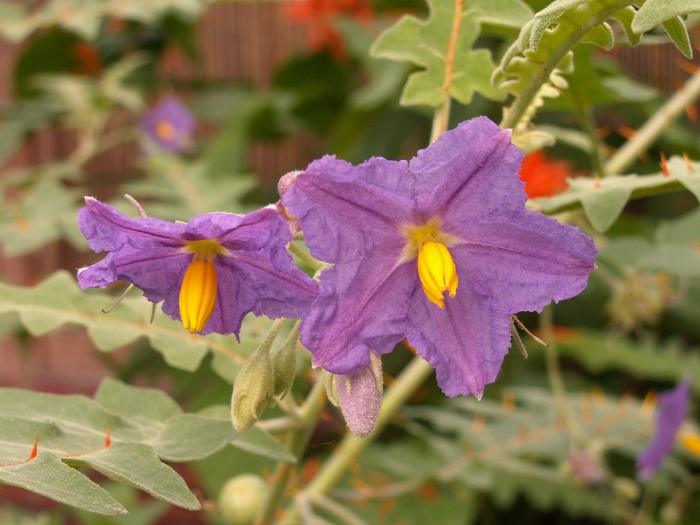Porcupine Tomato
(Solanum pyracanthos)
Porcupine Tomato (Solanum pyracanthos)
/
/

Dr. Boli
CC BY 2.0
Image By:
Dr. Boli
Recorded By:
Copyright:
CC BY 2.0
Copyright Notice:
Photo by: Dr. Boli | License Type: CC BY 2.0 | License URL: https://creativecommons.org/licenses/by-sa/2.0/ | Uploader: Dr. Boli | Publisher: Flickr |













Estimated Native Range
Summary
Solanum pyracanthos, commonly known as Porcupine Tomato, is an evergreen shrub native to the spiny forests of Madagascar. This plant is characterized by its striking fluorescent orange thorns that cover the stems and leaves, contributing to its unique and somewhat intimidating appearance. Typically, Porcupine Tomato reaches a height of 1–5 ft (0.30–1.52 m), but under optimal conditions, it can exceed these dimensions. The shrub is not frost-tolerant and will succumb to prolonged exposure to temperatures below freezing, although it may resprout from the base if the roots are not damaged.
Porcupine Tomato is valued for its ornamental qualities, including its unusual thorns and vibrant purple flowers that bloom in the spring and summer. The flowers are moderately showy, adding a splash of color to the garden. It is often used in thematic gardens to add texture and interest or as a conversation piece due to its unique appearance. The plant thrives in full sun and requires moderate watering, preferring a warm climate and well-drained soil that ranges from mildly acidic to mildly alkaline. While it is a prolific seed producer, gardeners should manage its spread to prevent unwanted seedlings, which can be quite vigorous and quickly develop thorns. Potential problems include vulnerability to frost and the need to control its aggressive self-sowing.CC BY-SA 4.0
Porcupine Tomato is valued for its ornamental qualities, including its unusual thorns and vibrant purple flowers that bloom in the spring and summer. The flowers are moderately showy, adding a splash of color to the garden. It is often used in thematic gardens to add texture and interest or as a conversation piece due to its unique appearance. The plant thrives in full sun and requires moderate watering, preferring a warm climate and well-drained soil that ranges from mildly acidic to mildly alkaline. While it is a prolific seed producer, gardeners should manage its spread to prevent unwanted seedlings, which can be quite vigorous and quickly develop thorns. Potential problems include vulnerability to frost and the need to control its aggressive self-sowing.CC BY-SA 4.0
Plant Description
- Plant Type: Shrub
- Height: 4-6 feet
- Width: 4-6 feet
- Growth Rate: Moderate
- Flower Color: Purple
- Flowering Season: Spring, Summer
- Leaf Retention: Evergreen
Growth Requirements
- Sun: Full Sun
- Water: Medium
- Drainage: Fast
Common Uses
Bee Garden, Bird Garden, Butterfly Garden, Deer Resistant, Drought Tolerant, Hummingbird Garden, Rabbit Resistant, Showy Flowers
Natural Habitat
Spiny forests of Madagascar
Other Names
Common Names: Feuerdorn-Nachtschatten, Eldskatta
Scientific Names: , Solanum pyracanthos, Solanum pyracantha, Solanum haematocarpum, Solanum runcinatum,
GBIF Accepted Name: Solanum pyracanthos Lam.